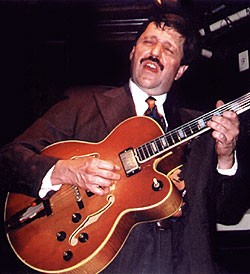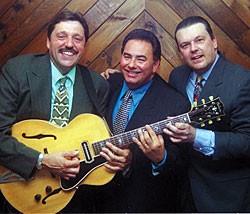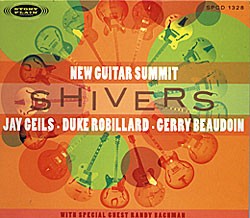
Beaudoin with his late-’60s Gibson L-5 in 1999.
One gets the feeling the three members of the New Guitar Summit have a lot of fun. Consisting of veteran guitarists Jay Geils, Duke Robillard, and Gerry Beaudoin, the NGS is in its second decade of purveying primarily-instrumental swing music that pays exuberant homage to original saints such as Charlie Christian, Benny Goodman, and Lionel Hampton. And in spite of active individual careers, they’ve found time to record four albums and a live DVD.
Gerry Beaudoin has been playing guitar since he was 10 years old and grew up admiring the Beatles as well as singer/songwriters like Kris Kristofferson and Joan Baez. He recalled hearing Robillard in concert around the same time he heard the first album by the J. Geils Band.
“Jay and Duke had known each other since the late ’60s,” Beaudoin detailed. “Jay had the J. Geils Blues Band; Duke had Roomful of Blues. I’m younger, and a cousin took me to see Roomful of Blues when I was in junior high school. I fell in love with Duke’s playing – it changed my whole focus on music. My high school band director let me put together a little jump-music sextet. My father bought me the first J. Geils Band album for Christmas one year, and I listened to it all day, trying to figure out Jay’s licks. I loved the Allman Brothers; I was playing blues in high school, but I still played in a jazz band. I went to Berklee (School of Music), and I can’t stress enough how I got the best education possible there – theory, harmony, arranging, great guitar instructors. I was totally immersed in the jazz scene. That’s how I built my career, but my style is pretty bluesy.”
During his days at Berklee, Beaudoin played a ’68 Gibson Les Paul goldtop. Considering how his style was developing, he realized the need for a jazz box
“My father and I went to New York one weekend and bought a gorgeous sunburst late-’68/early-’69 Gibson Super 400 for $800,” he recalled. “And I put a DeArmond pickup on it. I also bought a 1970 (Gibson) ES-335, which I wish I still had.

The New Guitar Summit: Gerry Beaudoin, Duke Robillard, and Jay Geils. Photo: Daniel Fogel.
“If you want to get into jazz, there’s no better place than New York,” he added. “My sister was going to Columbia University, so I made every excuse in the world to go visit her as often as I could! I saw all the great players in New York – Kenny Burrell, Jim Hall, Chuck Wayne, Joe Puma. One night, I saw Bucky Pizzarelli’s trio at the Cafe Pierre, and he was playing a seven-string. I had no idea what it was. The next weekend, he was playing Pier 77 when I showed up. He showed me a couple things on the guitar, and I sat in. That was it – I looked in the want ads, found a Gretsch George Van Eps seven-string, and paid $600 for it.
“I consider Bucky a mentor; he’s been the greatest friend and inspiration to me. Every seven-string guitarist in my generation owes Bucky, because he set the standard.”
Beaudoin has also gigged with a late-’60s Gibson L-5, and he currently endorses Benedetto seven-string guitars. His association with that brand and configuration came about at the insistence of Pizzarelli.
“I showed up with my L-5 at a gig where Bucky was playing,” Gerry recalled. “He was disappointed because he thought I still had my Van Eps. He called Bob and Cindy (Benedetto) the next day, telling them I needed a seven-string. I now have two and love playing them; I think the seventh string really adds something.”
Beudoin’s primary gigs had been with the Boston Jazz Ensemble, and he recorded albums with David Grisman.
“Since the Grisman recordings were pure acoustic, I played my Stromberg,” he recalled.
The opportunity to work with Geils and Robillard seemed to have been in the cards, and he recalled with a chuckle a notion about the New Guitar Summit and how Robillard is the “blueser,” Geils is the “rocker,” and Beaudoin is the “jazzer” – and together, they play swing!
“That’s exactly what the perception was when we formed,” Beaudoin recalled with a laugh. “And our first agent couldn’t get it straight! I’d met Duke in ’85 and we’ve been friends ever since. In 1992, I was playing at a guitar show in Washington, and Jay introduced himself after my set, telling me he had some of my records. He started guesting with my trio. One night I was actually gigging with Duke when Jay showed up and sat in. So that was the beginning.”

The NGS has a policy of including at least one Charlie Christian or Benny Goodman song on every album, and Shivers (Stony Plain) continues the tradition with both the title track and “Flying Home.” There are also two Mose Allison numbers, “Your Mind Is On Vacation” and “Everybody’s Crying Mercy,” which include guitar and vocals from guest artist Randy Bachman, with whom the NGS had collaborated on an album called Jazzthing II, recorded in one day during an NGS tour in ’07.
Beaudoin is an avid composer, so most of the original NGS songs were written by him. He noted that he was pleased with the way “Mediterranean Nights,” a duo between Geils and himself, turned out on Shivers, and he also cited “Blue Sunset” as having a “Kenny Burrell minor-blues mode.”
Shivers continues an “if it ain’t broke don’t fix it” attitude for the New Guitar Summit. “We love doing this kind of music,” Beaudoin said, summarizing. “And since we love Kenny Burrell, Charlie Christian, and Oscar Moore, we also want to try to educate people about the guys who wrote the book.”
This article originally appeared in VG‘s December 2008 issue. All copyrights are by the author and Vintage Guitar magazine. Unauthorized replication or use is strictly prohibited.



